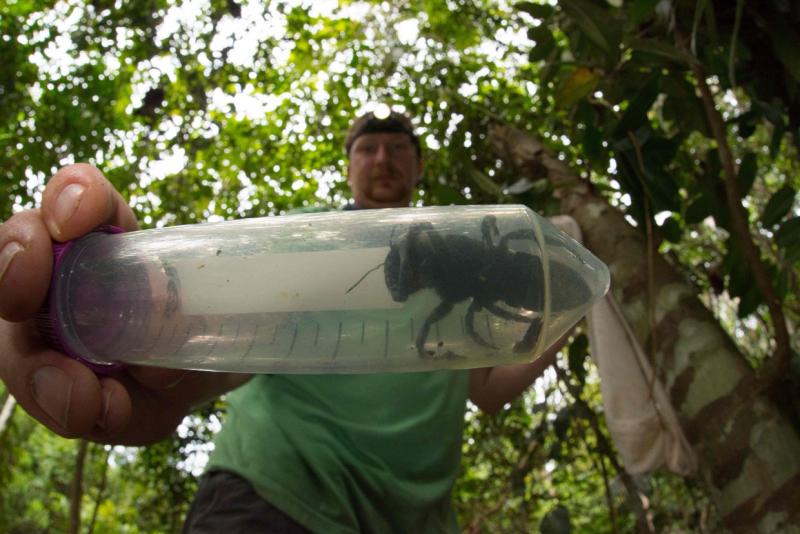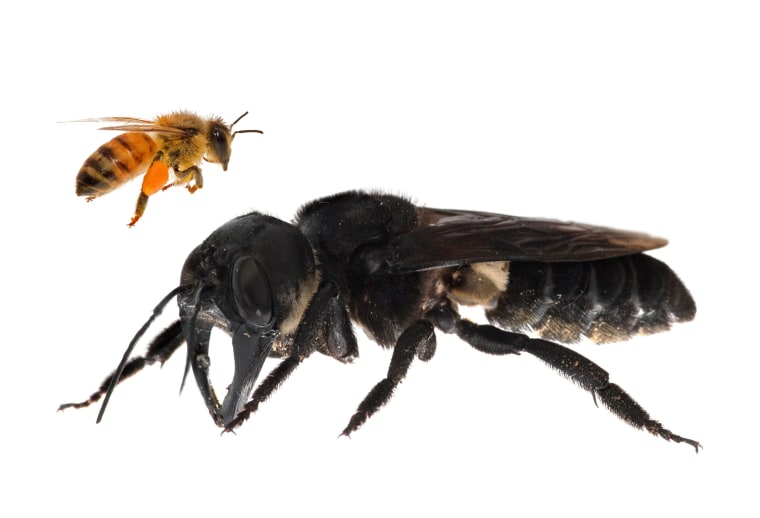World's largest bee, once feared extinct, rediscovered in Indonesia



The world’s largest bee, last seen by a scientist in 1981, is not extinct after all.
A single female was found and documented earlier this year on an Indonesian island, an Australian university and other groups said Thursday.
The bee, Megachile pluto , also known as "Wallace's giant bee" — named after British naturalist Alfred Russel Wallace who discovered it — was seen in January in Indonesia's North Moluccas island group by an international team of researchers looking for the rare species, the University of Sydney said .
"Amid such a well-documented global decline in insect diversity, it's wonderful to discover that this iconic species is still hanging on," team member Simon Robson, honorary professor of the university’s school of life and environmental sciences, said in a statement released by the educational institution.
The bee has a wingspan of more than two and a half inches and is considered the world's largest. Female bees make their nests in termite nests, and the team found the single female giant bee in a termite nest in a tree and about 8 feet off the ground, the university said.
The bee was documented and released.
 This undated handout photomontage provided by Global Wildlife Conservation on February 21, 2019, shows a living Wallaces giant bee (Megachile pluto) (R), which is approximately four times larger than a European honeybee, after it was rediscovered in the Indonesian islands of the North Moluccas. Clay Bolt / Global Wildlife Conservation via AFP - Getty Images
This undated handout photomontage provided by Global Wildlife Conservation on February 21, 2019, shows a living Wallaces giant bee (Megachile pluto) (R), which is approximately four times larger than a European honeybee, after it was rediscovered in the Indonesian islands of the North Moluccas. Clay Bolt / Global Wildlife Conservation via AFP - Getty Images
A guide and conservationist, Iswan, climbed up and thought he saw something move, and entomologist Eli Wyman of Princeton University and the American Museum of Natural History climbed up and was certain that it was a bee's nest, photographer Clay Bolt wrote in an account of the discovery published online Thursday by the group Global Wildlife Conservation in Austin, Texas. The group, which supported the effort, runs a lost species program.
"The structure was just too perfect and similar to what we expected to find," Bolt wrote. "I climbed up next, and my headlamp glinted on the most remarkable thing I'd ever laid my eyes on. I simply couldn’t believe it:
"We had rediscovered Wallace's Giant Bee."
It was documented and released back to the nest.
A message to Bolt was not immediately returned Thursday afternoon. A message sent seeking comment from Wyman through the American Museum of Natural History, where he is a visiting scientist, had not been returned either.
The team traveled to Indonesia in late January, which was around the same time of year that the insect was encountered by Wallace and Adam Messer, who last saw the species in 1981, Bolt wrote in his account. The bee was found on the last day of a five-day stop in the area, the University of Sydney said.
"Messer's rediscovery gave us some insight, but we still know next to nothing about this extraordinary insect," Wyman said in the University of Sydney statement. "I hope this rediscovery will spark research that will give us a deeper understanding of this unique bee and inform any future efforts to protect it from extinction."
The size of the huge bee dwarfs that of a honeybee.
"It was absolutely breathtaking to see this 'flying bulldog' of an insect that we weren’t sure existed anymore," Bolt said in a statement released by the university. Bolt took the first photos and video of the bee after the discovery, the university said.
The discovery raises hopes that more could be found in Indonesia's forests, according to the University of Sydney.
Lynn S. Kimsey, professor of entomology and the director of the Bohart Museum of Entomology at the University of California, Davis, said that the discovery is significant, but that there are many insect species that have not been collected in a long period of time. Kimsey was not involved in the search for the giant bee.
Kimsey, who did field work about the "warrior wasp" in the Indonesian island of Sulawesi, said tropical environments provide many places for species to go unnoticed.
"It’s one of those things about tropical regions, that the environment is so complex that the chances of missing something are pretty damn good," she said.
"If you found one, chances are there’s a population there," she said. "But finding a female is a good thing."


I don't think I have an epi pen big enough for this bee.
This bee does not have a stinger from my understanding. It is even more docile than a bumble bee, which I have had land on me multiple times while on the farm.
Well, that is good to know! Of course, those pinchers don't look like fun, but at least I wouldn't suffocate to death, LOL.
I would Pee. My. Pants . . . while running as fast as I could, of course. I'm a big enough baby with ordinary bugs. This is like the stuff of my nightmares.
Once, while riding a motorcycle, I had a bee fly into my helmet and up my nose. I then blew snot and bee parts all over the inside of my face shield while shaking my head violently.
In a McDonald's parking lot in Ft. Worth, I was attacked by an entire colony of red fire ants that swarmed up both my legs. I ran into the restroom and jumped into the sink.
When I took zoology in college, one day we had to examine the world's largest grasshopper. I took notes from across the room.
Bugs and I have a long, dark history.
Don't look below.
I feel ya pain Tacos.
Actually, I am not afraid of most insects. Just the ones that bite or sting. I seem to react to all of those. It's why I didn't go into anthropology. All the best digs are in areas where there are stinging bugs galore!
Yeah made during the 70's killer bees panic.....
more funny than horrific....
I could post it if anyone is interested...
unbelievable
.
i heard right winged 'scientists' wanted to know why this B wasnt example A, and dissected, so as to discover Y it went X TINCT
I wanted to seed this, but I couldn't figure out a way to grab. the video.
Cool topic.
Where is the video? I can't find it at the seeded article. If I can't grab it no one can....
This story has been in several sources. I'll see if I can find it, and get back to you.
Got it....
You Tube....
And the web page it came from .....
The one I saw was some proprietary format, about a minute and a half... I'll try to send you the link...
No luck.
What you found has the essential.
Okay, after seeing the video, I fully agree with XDm9mm's comment in #7. Leave it alone. The stories I read did not mention that they actually captured it even for a little bit.
What a little cutie, however may I suggest we don't try to crossbreed this one with an African honey bee. That went badly last time and this would be worse.
Good idea!!
Holy hell!
I love bees but that one looks prehistoric.
Kill them with fire.
...?
A firm now known as Exxon Mobil used to be two different companies.
One was Esso.
An insect not seen since the merger was called the Esso Bee.
Hope this information doesn't bug anyone.
Brothers and Sisters: Let us spray!
Enoch.
ever wonder why they are so soft
on firms ?
I did once
.
,
.
let me know, when i'm done , wondering please,
thank U
Dear Friend Ignorantzrulz: Firms are also called "concerns", "companies", and "businesses".
Many concerns are not concerned with anyone but themselves.
Too often. a company isn't very good social company.
During non-peak seasons, a business isn't very busy.
What's in a name?
A rose by any other moniker would still be thorny.
P&AB.
E.
ouch !
did you just, in so many words,
call me a prick ly thorn in your side...
cause if so, it was deserved.
Sorry RA for off topic, but u no i' sumtymez fly in da ointment
wear topical gel
n sumtin bout Mary's as well, don't in all ways feel swell,
but i do care about the health of my hair apparently not.
.
I Be leavin you need to ban me from your writing abilities, cause i don't want to B Disability i can't overcome, and i'm too set in my commonly uncommon waze, to change much
.
Won't b first time i got flagged from Church.
you, and your good fellowed and natured group of authors are all fine writers, and my comments cause the Bell Curve to bend till woops i've done it again, dropped the ball, and your group IS truly admired from afarr, but, best from afurther
N joy your Day, i've gotta go earn me some fun tickets
n again
didn't mean to spoil the spoils
, i just didn't want them to go bad, without my cold embrace many X's i guess... as aren't Oh's Hershey Kisses ?
i m not sure, but do keep up the good work
m y commentary is not meant to demean, just yet another vent
i need some new ducts, in a row, i'm guessin
N Joy
out